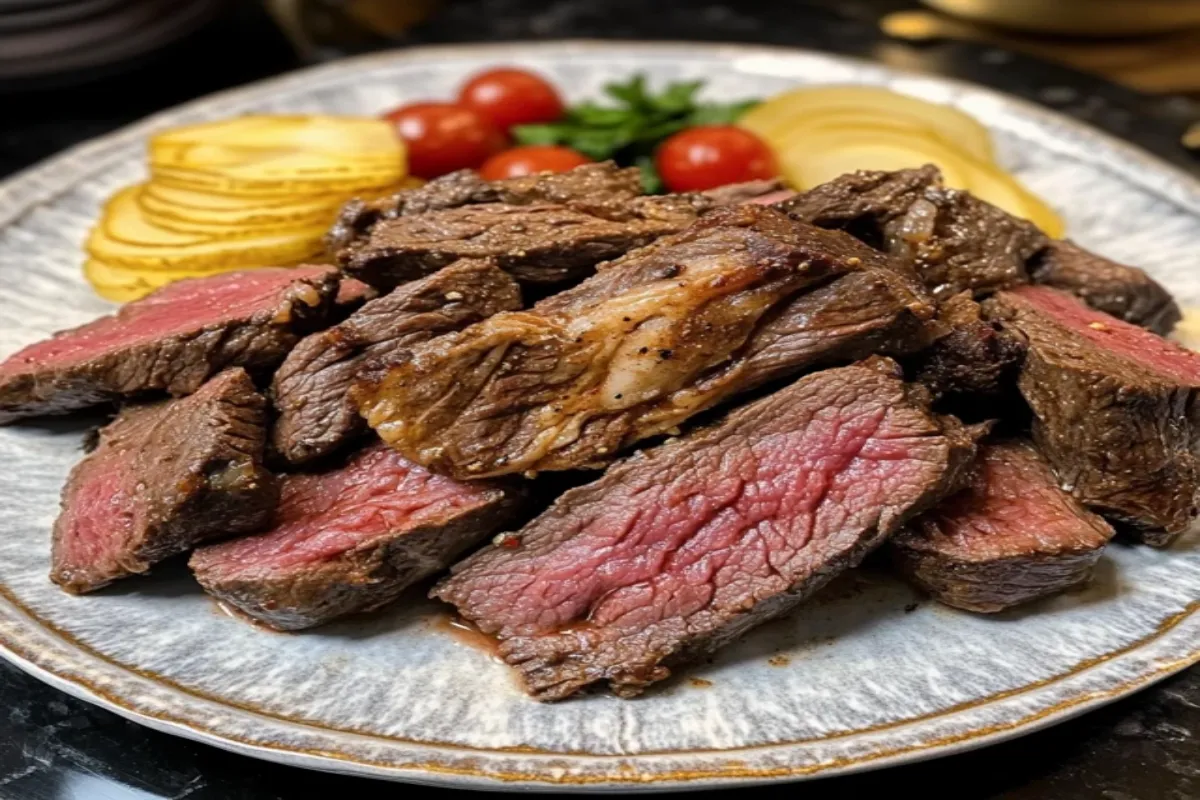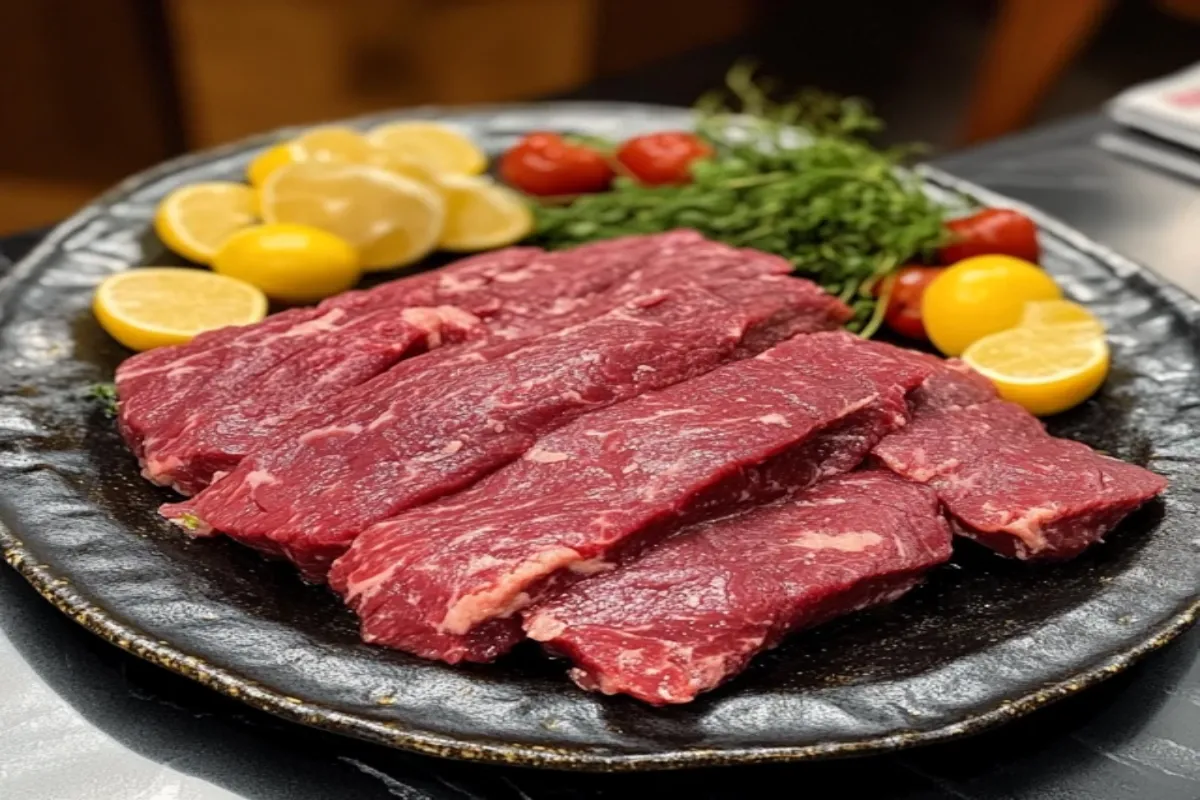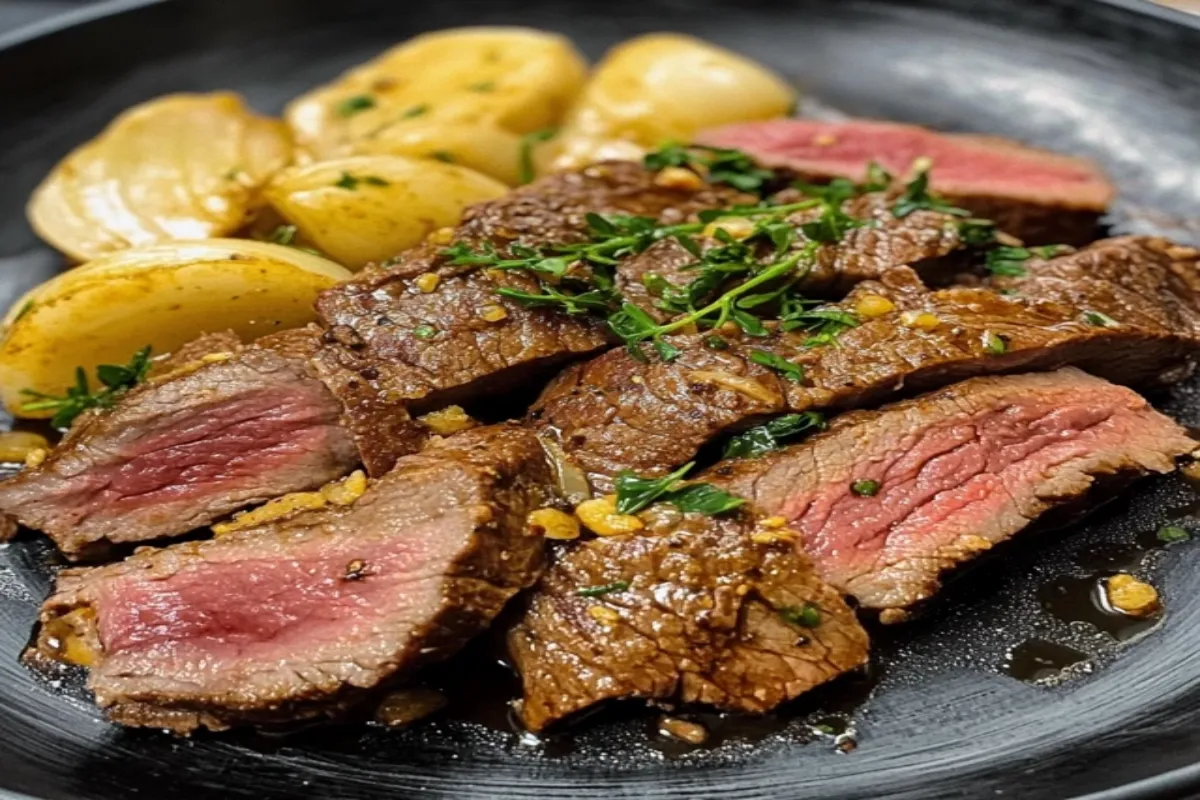Beef skirt substitute is renowned for its rich flavor and versatility in various cuisines. However, due to its limited availability and rising demand, finding suitable alternatives is essential for culinary enthusiasts. This guide delves into the best substitutes for beef skirt steak, their unique characteristics, and how to prepare them effectively.
Introduction
Beef skirt steak is a long, flat cut from the cow’s diaphragm muscles, prized for its intense beefy flavor and distinct grain. Commonly used in dishes like fajitas and stir-fries, its popularity can make it scarce and often more expensive. Fortunately, several other beef cuts can replicate its texture and taste, allowing for flexibility in various recipes.
1. Understanding Beef Skirt Steak
1.1 Characteristics of Skirt Steak
Skirt steak is known for:
- Flavor: Deep, robust beefy taste.
- Texture: Long muscle fibers with a pronounced grain, leading to a chewy yet tender bite when sliced correctly.
- Cooking Methods: Best suited for high-heat, quick cooking techniques like grilling or searing.
1.2 Culinary Uses
Popular dishes featuring skirt steak include:
- Fajitas: A Tex-Mex favorite where the steak is marinated, grilled, and sliced thinly.
- Carne Asada: A Latin American dish involving marinated and grilled steak, often served with tortillas.
- Stir-Fries: Quick-cooked with vegetables and sauces for a flavorful meal.
2. Top Substitutes for Skirt Steak
2.1 Flank Steak
Flank steak, cut from the cow’s abdominal muscles, is a popular alternative due to its similar texture and flavor profile.
- Flavor: Comparable beefy taste.
- Texture: Slightly leaner with a prominent grain.
- Cooking Tips: Marinate to enhance tenderness and flavor; cook over high heat to medium-rare to prevent toughness.
2.2 Hanger Steak
Also known as the “butcher’s steak,” hanger steak comes from the diaphragm area and offers a rich taste.
- Flavor: Intense, beefy flavor.
- Texture: Tender with adequate marbling.
- Cooking Tips: Best when grilled or pan-seared to medium-rare; overcooking can lead to a chewy texture.
2.3 Flat Iron Steak
Derived from the cow’s shoulder, flat iron steak is known for its tenderness.
- Flavor: Rich and beefy.
- Texture: Tender with uniform thickness.
- Cooking Tips: Suitable for grilling or broiling; minimal marinating required.
2.4 Flap Steak (Sirloin Tip)
Flap steak, often confused with flank steak, comes from the bottom sirloin.
- Flavor: Robust beef flavor.
- Texture: Coarse grain, slightly chewy.
- Cooking Tips: Marinate to enhance tenderness; ideal for grilling and slicing thinly against the grain.
2.5 Tri-Tip Steak
Cut from the bottom sirloin, tri-tip is flavorful and versatile.
- Flavor: Rich and beefy.
- Texture: Tender with some marbling.
- Cooking Tips: Best when grilled or roasted; benefits from marinating.
2.6 Sirloin Steak
Sirloin steak is a widely available cut known for its balance of flavor and tenderness.
- Flavor: Mild beef flavor.
- Texture: Lean with fine grain.
- Cooking Tips: Versatile; can be grilled, broiled, or pan-seared.
2.7 Ribeye Steak
Ribeye is a premium cut known for its marbling and tenderness.
- Flavor: Rich and juicy.
- Texture: Highly tender due to marbling.
- Cooking Tips: Ideal for grilling or pan-searing; minimal seasoning needed.
2.8 Beef Tenderloin
Also known as filet mignon, beef tenderloin is the most tender cut.
- Flavor: Mild beef flavor.
- Texture: Extremely tender.
- Cooking Tips: Suited for grilling, roasting, or pan-searing; often served with sauces to enhance flavor.
3. Cooking Techniques for Skirt Steak Substitutes
3.1 Marinating for Enhanced Flavor and Tenderness
Marinating helps break down muscle fibers and infuse flavor.
- Ingredients: Combine acidic components (e.g., citrus juice, vinegar) with herbs, spices, and oils.
- Duration: Marinate for at least 30 minutes to 4 hours, depending on the cut and desired flavor intensity.
3.2 Grilling and Broiling
High-heat cooking methods like grilling and broiling are ideal for these cuts.
- Preparation: Preheat grill or broiler; ensure meat is at room temperature.
- Cooking: Sear each side for 3-5 minutes until desired doneness.
- Resting: Allow meat to rest for 5-10 minutes after cooking to retain juices.
- Slicing: Cut against the grain to ensure tender bites.
-
6. Techniques to Elevate Your Cooking with Beef Skirt Steak Substitutes
6.1 The Importance of Marbling
When choosing a beef skirt steak substitute, marbling plays a critical role. Marbling refers to the fat streaks within the meat, which melt during cooking, adding flavor and moisture.
- Cuts with High Marbling: Ribeye and hanger steak are excellent choices.
- Leaner Cuts: Flank steak or sirloin may require marinades or cooking techniques that retain moisture.
6.2 Enhancing Flavor with Seasonings
Seasoning is vital for all substitutes, ensuring each cut retains its distinct taste while enhancing its natural beefy flavor.
- Basic Seasonings: Salt, pepper, and garlic are staples.
- Marinades: Combine soy sauce, lime juice, and cumin for a Tex-Mex profile.
- Dry Rubs: Use smoked paprika, chili powder, and oregano for grilling.
6.3 Balancing Cooking Times and Temperatures
Each substitute has its optimal cooking temperature for the perfect texture and flavor.
- Medium-Rare Goal: 130°F–135°F (55°C–57°C) for most cuts.
- Resting Is Key: Always allow meat to rest for 5–10 minutes after cooking to let the juices redistribute.
6.4 Utilizing Meat Thermometers
A meat thermometer ensures precision, especially for substitutes that cook differently from skirt steak.
- Insert the thermometer into the thickest part of the meat.
- Remove from heat just before the desired temperature, as residual heat will continue cooking.
7. Creative Recipe Ideas with Beef Skirt Substitutes
7.1 Flank Steak Fajitas
Ingredients:
- 1 pound of flank steak
- Bell peppers (assorted colors)
- Onions
- Fajita seasoning mix
- Tortillas
Steps:
- Marinate flank steak in lime juice, garlic, and fajita seasoning for 2 hours.
- Grill steak over high heat, then rest for 5 minutes.
- Slice against the grain and serve with sautéed peppers and onions in tortillas.
7.2 Hanger Steak Stir-Fry
Ingredients:
- 1 pound of hanger steak
- Soy sauce, sesame oil, and ginger for marinade
- Mixed vegetables (broccoli, carrots, bell peppers)
- Rice or noodles
Steps:
- Slice hanger steak into thin strips and marinate for 30 minutes.
- Stir-fry the vegetables until tender-crisp, set aside.
- Sear steak in a hot pan, then return vegetables to combine. Serve over rice or noodles.
7.3 Flat Iron Steak Salad
Ingredients:
- 1 pound of flat iron steak
- Mixed greens
- Cherry tomatoes, red onions, and avocado
- Balsamic vinaigrette
Steps:
- Grill flat iron steak to medium-rare and let it rest.
- Assemble greens and toppings, then slice steak thinly against the grain.
- Drizzle with vinaigrette and serve.
8. Maximizing the Shelf Life of Beef Substitutes
8.1 Proper Storage
- Store fresh beef in the refrigerator at or below 40°F (4°C).
- For longer storage, freeze in vacuum-sealed bags to prevent freezer burn.
8.2 Thawing Safely
- Thaw frozen beef in the refrigerator for 24 hours.
- Avoid counter thawing to prevent bacterial growth.
8.3 Repurposing Leftovers
Use leftover beef substitutes in:
- Sandwiches or wraps.
- Soups and stews.
- Tacos or quesadillas.
9. Advanced Tips for Cooking Beef Substitutes
9.1 Sous Vide Cooking
For perfect tenderness, sous vide cooking is an excellent method for tougher cuts like flap steak.
- Set sous vide to the desired doneness temperature (e.g., 130°F for medium-rare).
- Vacuum-seal the steak with herbs and cook for 1-2 hours.
- Finish with a quick sear for texture and flavor.
9.2 Smoking Techniques
For a smoky, tender steak, use a smoker or a grill with wood chips.
- Select cuts like tri-tip or hanger steak for their ability to absorb smoky flavors.
- Maintain a low, steady temperature of 225°F (107°C) until the internal temperature reaches 125°F for medium-rare.
9.3 Reverse Searing
Perfect for thicker cuts like ribeye, reverse searing ensures even cooking:
- Bake steak in the oven at 275°F until it reaches 10°F below the desired doneness.
- Sear in a hot skillet for 1-2 minutes per side to create a crust.
10. Exploring Global Alternatives to Skirt Steak
10.1 International Beef Cuts
In various cuisines, alternative beef cuts mirror the skirt steak‘s characteristics. These options expand the culinary possibilities for adventurous cooks.
- Argentina: Entraña is the traditional name for skirt steak in Argentine cuisine, often grilled over an open flame and served with chimichurri.
- Korea: Bulgogi cuts, typically thinly sliced beef such as ribeye or sirloin, work well in marinades and high-heat cooking.
- Japan: Karubi, a cut used for yakiniku (Japanese BBQ), is a fatty short rib that can serve as a tender substitute.
10.2 Non-Beef Substitutes from Global Cuisine
For those who prefer non-beef options, consider these alternatives:
- Pork Shoulder (Latin America): Often used in tacos and carnitas, pork shoulder provides a rich, slow-cooked flavor.
- Lamb Cuts (Middle East): Lamb leg or shoulder offers robust flavor, ideal for grilling or roasting.
- Duck Breast (France): A unique substitute, duck breast can be seared or grilled for a gourmet twist.
11. Pairing Beef Substitutes with Sides and Sauces
11.1 Side Dishes to Complement Beef Substitutes
Pair your beef substitute with sides that highlight their flavor:
- Grilled Vegetables: Zucchini, eggplant, and bell peppers add smoky notes.
- Starches: Mashed potatoes, sweet potato fries, or rice pilaf balance the richness of the meat.
- Salads: A light arugula or mixed greens salad cuts through the heaviness of the beef.
11.2 Sauces to Enhance Flavor
Elevate your beef substitute with these sauce options:
- Chimichurri: A fresh blend of parsley, garlic, olive oil, and vinegar adds brightness.
- Béarnaise: A classic French sauce that pairs well with tender cuts like beef tenderloin.
- Barbecue Sauce: Sweet and smoky, ideal for cuts like flap steak or tri-tip.
12. Mistakes to Avoid When Using Beef Substitutes
12.1 Overcooking the Meat
Overcooking can make substitutes tough and dry. To avoid this:
- Use a meat thermometer to monitor internal temperature.
- Rest the meat to preserve juices.
12.2 Slicing Improperly
Failing to cut against the grain results in a chewier texture. Always identify the grain direction and slice perpendicular to it.
12.3 Skipping the Marinade
For leaner cuts like flank steak, skipping the marinade can lead to a lack of flavor. A good marinade tenderizes and infuses taste.
13. Budget-Friendly Alternatives
13.1 Economical Beef Cuts
For those seeking cost-effective options:
- Chuck Steak: Affordable and flavorful, but requires slow cooking.
- Brisket: Perfect for smoking or braising.
- Top Round Steak: Lean but tender when marinated and sliced thin.
13.2 Maximizing Value with Bulk Purchases
- Purchase larger cuts and portion them at home to save money.
- Freeze unused portions for future meals.
14. Nutritional Comparison of Skirt Steak and Substitutes
| Cut | Calories (per 4 oz) | Protein (g) | Fat (g) | Iron (%) |
|---|---|---|---|---|
| Skirt Steak | 210 | 22 | 14 | 15 |
| Flank Steak | 200 | 23 | 10 | 12 |
| Hanger Steak | 220 | 22 | 15 | 18 |
| Flat Iron Steak | 180 | 21 | 8 | 14 |
| Sirloin Steak | 150 | 26 | 6 | 10 |
| Ribeye Steak | 240 | 24 | 18 | 15 |
15. Sustainability and Ethical Considerations
15.1 Supporting Sustainable Beef Production
- Choose grass-fed or organic beef for a lower environmental impact.
- Support local farmers who practice ethical raising methods.
15.2 Exploring Plant-Based Beef Alternatives
For eco-conscious cooks, plant-based substitutes like Beyond Meat or Impossible Burger mimic beef flavor and texture while reducing environmental strain.
Conclusion:
Finding a suitable substitute for beef skirt steak opens the door to endless culinary possibilities. Whether you choose a bold and flavorful option like flank steak or a tender cut like flat iron steak, each alternative brings its unique characteristics to the table. By understanding the textures, flavors, and cooking methods of various substitutes, you can recreate the depth and richness of skirt steak in your favorite dishes.
Moreover, experimenting with global cuts and non-beef options enhances your cooking repertoire while catering to diverse preferences and dietary needs. Pairing these substitutes with the right sides, seasonings, and sauces ensures a memorable dining experience. Finally, focusing on sustainability and ethical sourcing not only elevates your dishes but also supports a more responsible and conscious approach to food.



7 thoughts on “Beef skirt substitute: Comprehensive Guide”